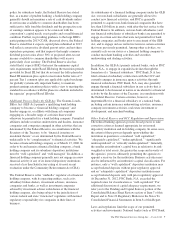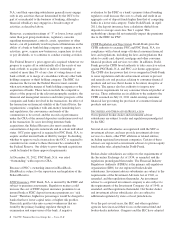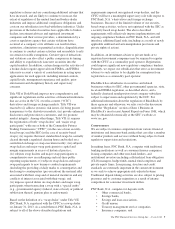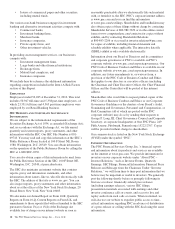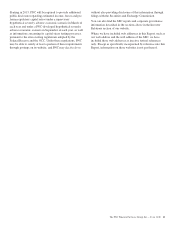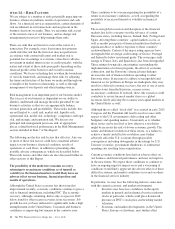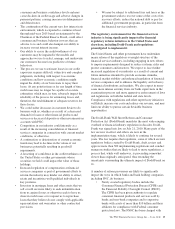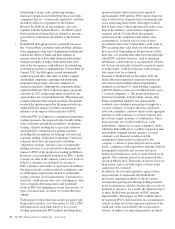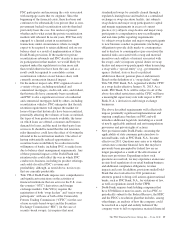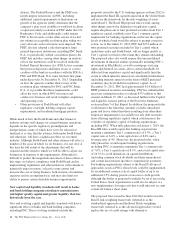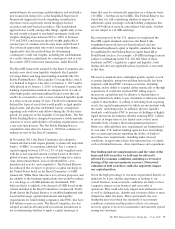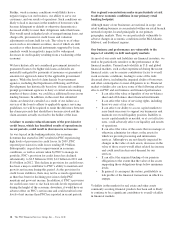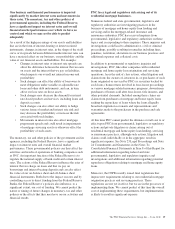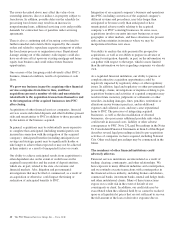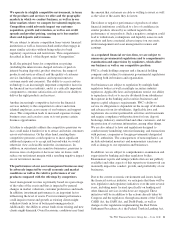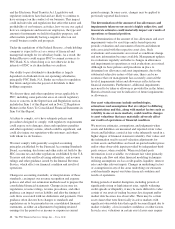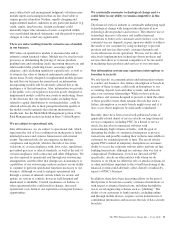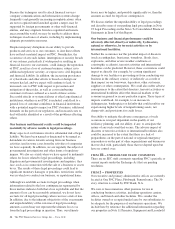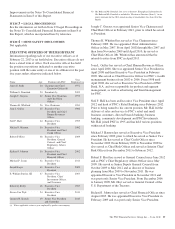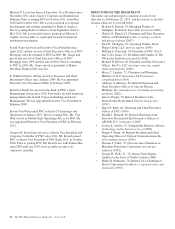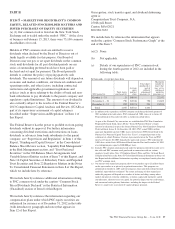PNC Bank 2012 Annual Report Download - page 36
Download and view the complete annual report
Please find page 36 of the 2012 PNC Bank annual report below. You can navigate through the pages in the report by either clicking on the pages listed below, or by using the keyword search tool below to find specific information within the annual report.methodologies for assessing creditworthiness and establish a
new framework (referred to as the Simplified Supervisory
Framework Approach) for risk-weighting securitization
exposures (such as privately issued mortgage-backed
securities and asset-backed securities). The standardized
approach also would, among other things, significantly revise
the risk weight assigned to residential mortgages (with risk
weights changing from between 50% to 100% to between
35% and 200%) and increase the risk weight applicable to
certain types of commercial real estate loans under Basel I.
The advanced approaches rule would, among other things,
significantly alter the methodology for determining
counterparty credit risk weights, including the establishment
of a credit valuation adjustment for counterparty risk in over-
the-counter (OTC) derivative transactions, under Basel II.
The Basel III framework adopted by the Basel Committee also
includes new short-term liquidity standards (the Liquidity
Coverage Ratio) and long-term funding standards (the Net
Stable Funding Ratio). The Liquidity Coverage Ratio, which
is scheduled to begin to take effect on January 1, 2015 and be
fully phased in by January 1, 2019, is designed to ensure that
banking organizations maintain an adequate level of cash, or
other high quality and unencumbered liquid assets that can
readily be converted to cash, to meet estimated liquidity needs
in a stress scenario lasting 30 days. The Basel Committee has
defined the types of assets that would qualify as high quality
liquid assets, and also has established various assumptions
regarding cash outflows and inflows during the 30-day stress
period, for purposes of the Liquidity Coverage Ratio. The Net
Stable Funding Ratio is designed to promote a stable maturity
structure of assets and liabilities of banking organizations over
a one-year time horizon. The Net Stable Funding Ratio is
scheduled to take effect by January 1, 2018 but continues to
undergo review by the Basel Committee.
In November 2011, the Basel Committee also adopted a
framework that would require globally systemically important
banks (“G-SIBs”) to maintain additional Tier 1 common
capital ranging between 1.0% to 2.5% of risk-weighted assets,
with the actual required amount varying based on the firm’s
global systemic importance as determined using five criteria
(size, interconnectedness, lack of substitutability, cross-
jurisdictional activity, and complexity). The Federal Reserve
has indicated that it expects to propose a capital surcharge in
the United States based on the Basel Committee’s G-SIB
framework. While these rules have not yet been proposed, and
the identity of the banking organizations that would be subject
to a surcharge as a G-SIB definitively determined, PNC
believes that it is unlikely to be deemed a G-SIB based on the
criteria included in the Basel Committee’s framework. Dodd-
Frank directs the Federal Reserve to establish heightened risk-
based and leverage capital requirements and liquidity
requirements for bank holding companies, like PNC, that have
$50 billion or more in assets. The Basel Committee also has
adopted an analytical framework for national jurisdictions to
use in determining whether to apply a capital surcharge to
firms that may be systemically important on a domestic basis
(“D-SIBs”), but that are not G-SIBs. The Federal Reserve has
stated that it is still considering whether to impose an
additional capital surcharge on bank holding companies that
have $50 billion or more in consolidated total assets, but that
are not subject to a G-SIB surcharge.
Because proposals by the U.S. agencies to implement the
Basel III capital standards and revise the Basel I risk-
weighting framework have not been finalized, and any
additional heightened capital or liquidity standards that may
be established by the Federal Reserve under Basel III or
Dodd-Frank (such as, for example, a D-SIB surcharge) remain
subject to rulemaking in the U.S., the full effect of these
standards on PNC’s regulatory capital and liquidity, both
during and after any applicable phase-in periods, is uncertain
at this time.
The need to maintain more and higher quality capital, as well
as greater liquidity, going forward than historically has been
required could limit PNC’s business activities, including
lending, and its ability to expand, either organically or through
acquisitions. It could also result in PNC taking steps to
increase its capital that may be dilutive to shareholders or
being limited in its ability to pay dividends or otherwise return
capital to shareholders, or selling or refraining from acquiring
assets, the capital requirements for which are inconsistent with
the assets’ underlying risks. In addition, the new liquidity
standards could require PNC to increase its holdings of highly
liquid short-term investments, thereby reducing PNC’s ability
to invest in longer-term or less liquid assets even if more
desirable from a balance sheet management perspective.
Moreover, although these new requirements are being phased
in over time, U.S. federal banking agencies have been taking
into account expectations regarding the ability of banks to
meet these new requirements, including under stressed
conditions, in approving actions that represent uses of capital,
such as dividend increases, share repurchases and acquisitions.
Our lending and servicing businesses and the value of the
loans and debt securities we hold may be adversely
affected by economic conditions, including a reversal or
slowing of the current moderate recovery. Downward
valuation of debt securities could also negatively impact
our capital position.
Given the high percentage of our assets represented directly or
indirectly by loans, and the importance of lending to our
overall business, weak economic conditions are likely to have
a negative impact on our business and our results of
operations. This could adversely impact loan utilization rates
as well as delinquencies, defaults and customer ability to meet
obligations under the loans. This is particularly the case
during the period in which the aftermath of recessionary
conditions continues and the positive effects of economic
recovery appear to be slow to materialize and unevenly spread
among our customers.
The PNC Financial Services Group, Inc. – Form 10-K 17


